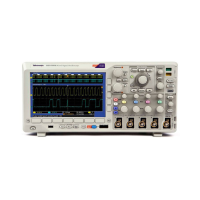Analyze Wavefor
mData
Using FFT
An FFT breaks down signals into component frequencies, which the oscilloscope uses to display a graph of the frequency
domain of a signal, as opposed to the oscilloscope's standard time domain g raph. You can match these frequencies with
known system frequencies, such as system clocks, oscillators, or power supplies.
1. Push Math.
2. Push FFT.
Dual Wfm
Math
FFT Advanced
Math
(M) Label
FFT
3. Push FFT Source on the side menu, if
needed, and turn multipurpose knob a to
select the source to use. Choices are:
channels 1, 2, 3, 4, reference waveforms
R1, R2, R3, and R4.
FFT
Source
1
4. Push Vertical Scale on the side menu
repeatedly to select either Linear RMS or
dBV RMS.
Vertical
Units
Linear
RMS
5. Push Window on the side m enu repeatedly
to select the desired window.
Window choices are: Rectangular,
Hamming, Hanning, and Blackman-Harris.
Window
Hanning
6. Push Horizontal on the side menu to
activate multipurpose knobs a and b to pan
and zoom the FFT display.
Horizontal
625kHz
1.25kHz-
/div
MSO3000 and DPO 3000 Series Oscilloscopes User Manual 113

